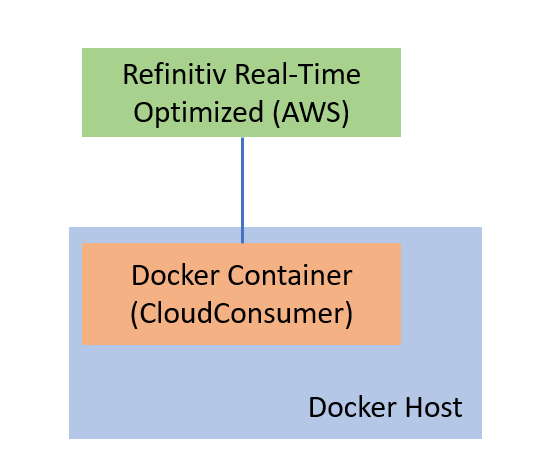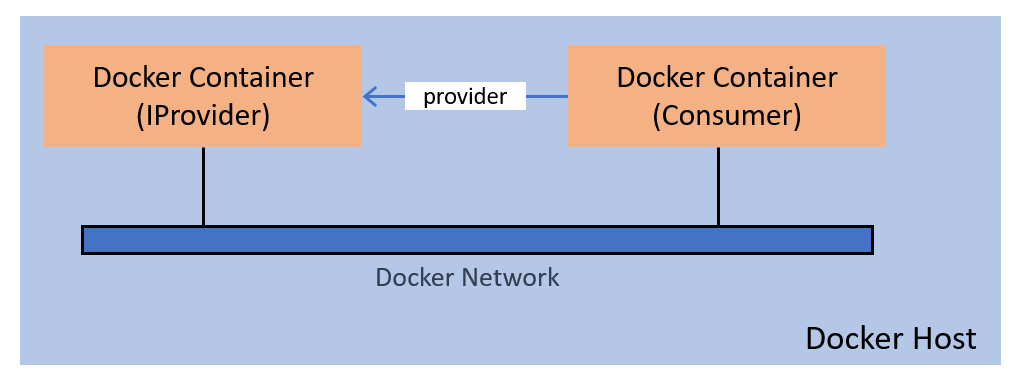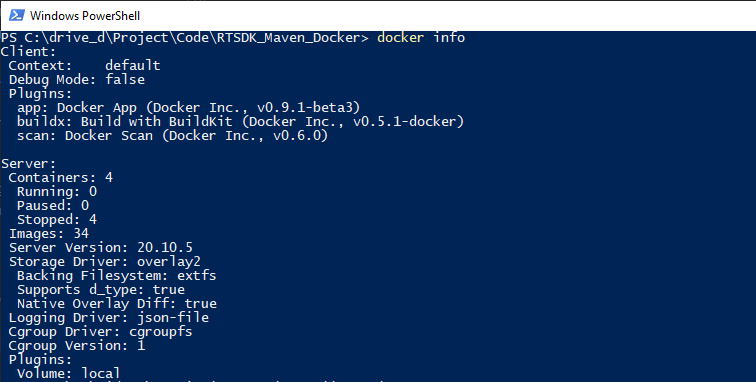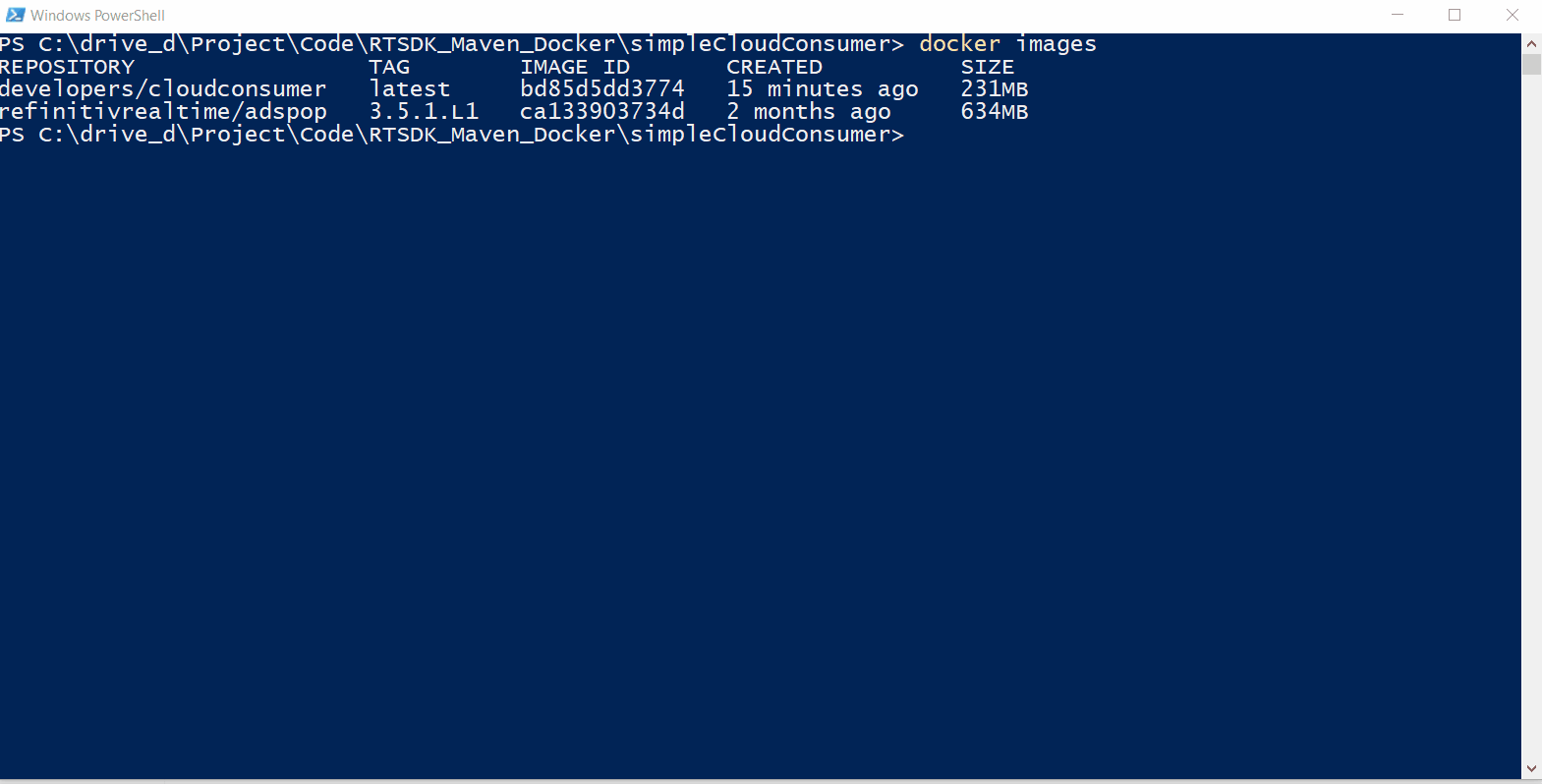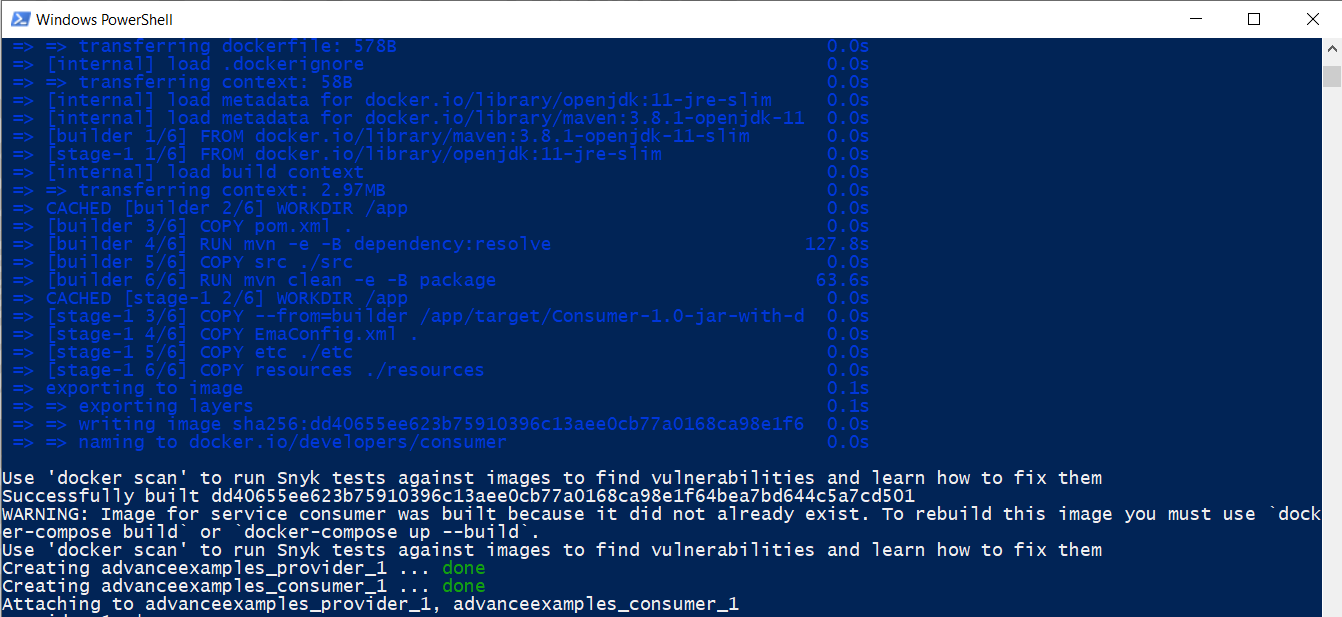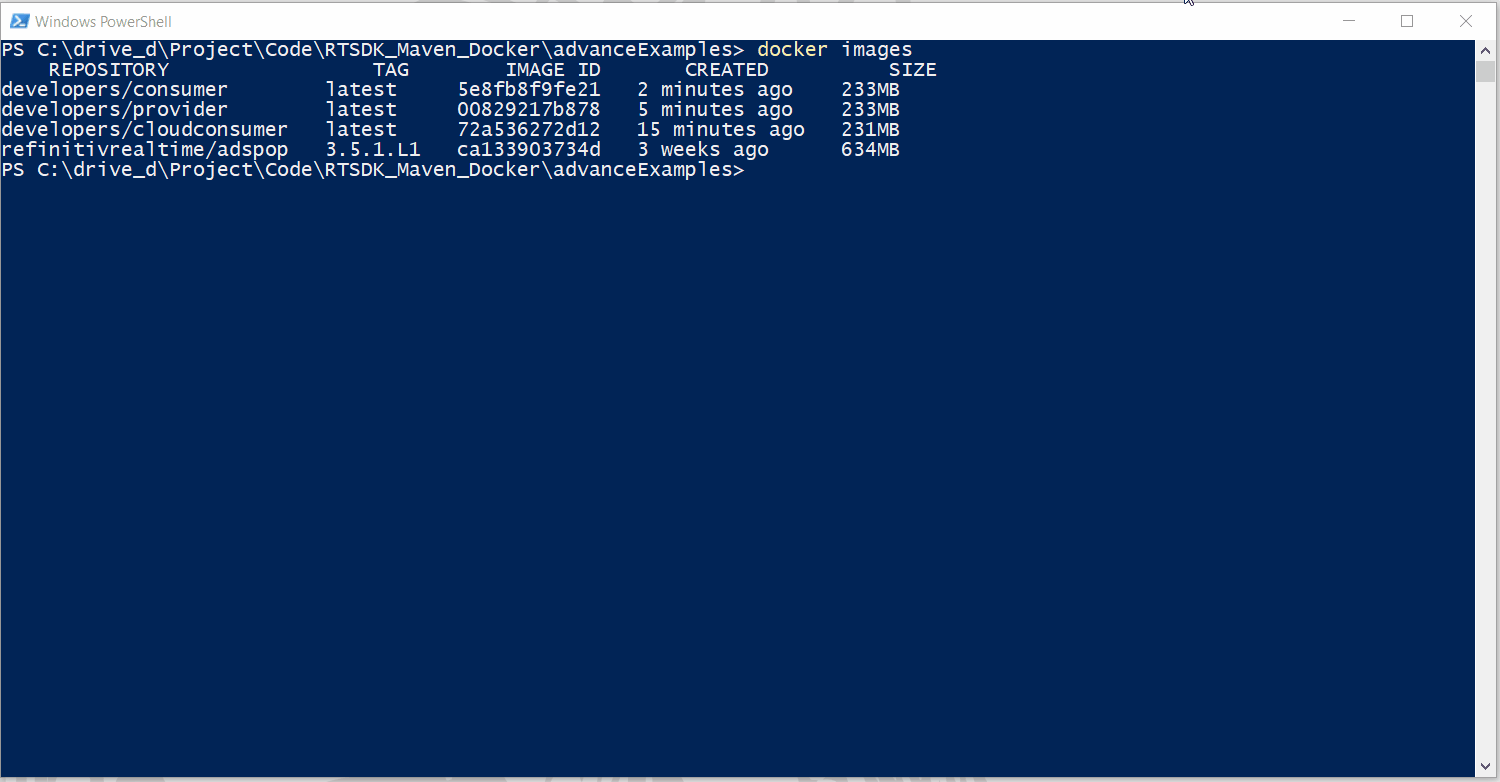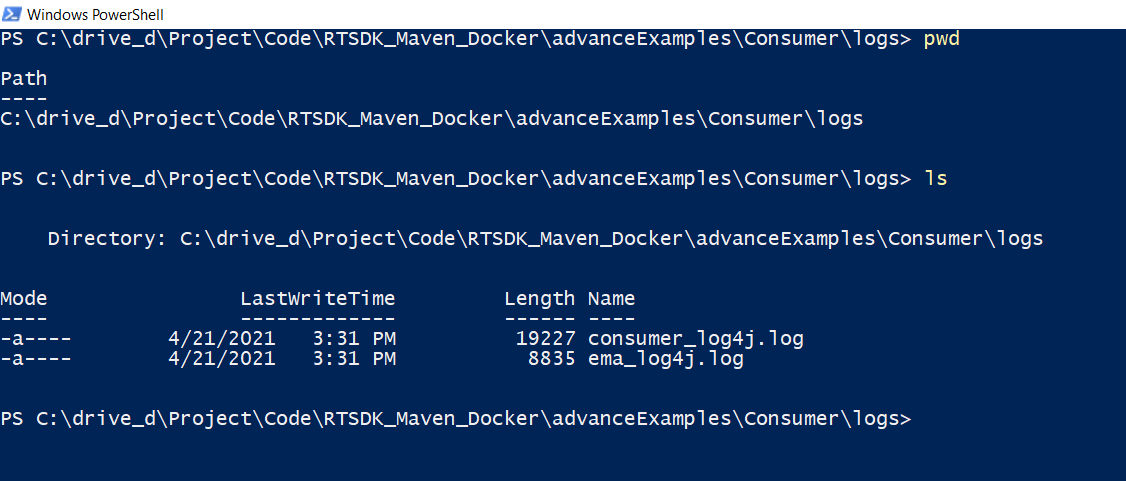
Introduction
Update: January 2022
As of December 2021: There are new serious vulnerabilities that were identified impacting the Apache Log4j utility. Please update the library to the latest version. You can find more detail regarding the vulnerability and the fix from the Apache Log4j Security Vulnerabilities page.
Refinitiv Real-Time SDK (Java Edition) (RTSDK, formerly known as Elektron SDK) is a suite of modern and open source APIs that aim to simplify development through a strong focus on ease of use and standardized access to a broad set of Refinitiv proprietary content and services via the proprietary TCP connection named RSSL and proprietary binary message encoding format named OMM Message. The capabilities range from low latency/high-performance APIs right through to simple streaming Web APIs.
Introduction to Docker
Docker is an open containerization platform for developing, testing, deploying, and running any software application. In Docker, the applications are presented as lightweight, portable, and self-sustaining containers which can be simultaneously run in a loosely isolated and virtual environment on a given host. Developers can use Docker to automate repetitive chores, such as setting up and configuring controlled development environments. Each environment or container has its resources that are independent of other containers. Numerous containers of separate applications are running on completely different stacks. Therefore, developers can avoid common problems, such as run-time library conflicts, and unsupported environments, and focus totally on developing software. Moreover, they can simply delete the containers without any footprints left on the host machine.
My colleague's Deploy and Run Refinitiv Real-Time SDK in Docker article already show how to deploy and run RTSDK applications in Docker by letting Docker downloads the SDK source code from GitHub, and build the SDK library and example applications from scratch. This scenario is suitable for developers who new to the SDK.
This article aims for helping Java developers who are already familiar with Maven to use the Java Builder container to resolve RTSDK Java library dependencies dynamically with Maven, then builds and runs the real-time applications in the container(s). This scenario is suitable for the Java developer team who already uses Maven in their project to set up a Development and Build environment via Docker.
Note: Please note that the Refinitiv Real-Time SDK isn't qualified on the Docker platform. This article and example projects aim for Development and Testing purposes only. If you find any problems while running it on the Docker platform, the issues must be replicated on bare metal machines before contacting the helpdesk support.
IMPORTANT Rebranding Announcement:
Starting with version RTSDK 2.0.0.L1 (same as EMA/ETA 3.6.0.L1), there are namespace changes and library name changes. Please note that all interfaces remain the same as prior releases of RTSDK and Elektron SDK and will remain fully wire compatible. Along with the RTSDK 2.X version, a REBRAND.md is published to detail the impact on existing applications and how to quickly adapt to the re-branded libraries. Existing applications will continue to work indefinitely as-is. Applications should be proactively rebranded to be able to utilize new features, security updates or fixes post 2.X release. Please see PCN for more details on support.
RTSDK Java with Maven
The Refinitiv Real-Time SDK Java is now available in Maven Central Repository. You can define the following dependency in Maven's pom.xml file to let Maven automatically download the EMA Java library and ETA Java library for the application.
For more detail regarding how to setup RTSDK Java project with Maven, please see How to Set Up Refinitiv Real-Time SDK Java Application with Maven article and GitHub Project pages
Note:
- This article is based on EMA Java version 3.6.1 L1 (RTSDK Java Edition 2.0.1 L1).
Simple EMA Java Consumer on Docker
Let's start with a simple EMA Java Consumer application that connects and consume data from Refinitiv Real-Time - Optimized (RRTO) on the Cloud. The application CloudConsumer is based on EMA Java Consumer ex450_MP_QueryServiceDiscovery example application.
Project Maven file
The application project is in Maven project layout and the Maven pom.xml file is the following:
<?xml version="1.0" encoding="UTF-8"?>
<project xmlns="http://maven.apache.org/POM/4.0.0" xmlns:xsi="http://www.w3.org/2001/XMLSchema-instance"
xsi:schemaLocation="http://maven.apache.org/POM/4.0.0 http://maven.apache.org/xsd/maven-4.0.0.xsd">
<modelVersion>4.0.0</modelVersion>
<groupId>com.refinitiv.ema</groupId>
<artifactId>cloud_consumer</artifactId>
<version>1.0</version>
<name>cloud_consumer</name>
<properties>
<project.build.sourceEncoding>UTF-8</project.build.sourceEncoding>
<maven.compiler.source>1.8</maven.compiler.source>
<maven.compiler.target>1.8</maven.compiler.target>
<rtsdk.version>3.6.1.0</rtsdk.version>
</properties>
<dependencies>
<!-- RTSDK -->
<dependency>
<groupId>com.refinitiv.ema</groupId>
<artifactId>ema</artifactId>
<version>${rtsdk.version}</version>
</dependency>
</dependencies>
<build>
<plugins>
<plugin>
<groupId>org.apache.maven.plugins</groupId>
<artifactId>maven-assembly-plugin</artifactId>
<executions>
<execution>
<phase>package</phase>
<goals>
<goal>single</goal>
</goals>
<configuration>
<archive>
<manifest>
<mainClass>
com.refinitiv.ema.cloud.CloudConsumer
</mainClass>
</manifest>
</archive>
<descriptorRefs>
<descriptorRef>jar-with-dependencies</descriptorRef>
</descriptorRefs>
</configuration>
</execution>
</executions>
</plugin>
</plugins>
</build>
</project>
The above Maven pom.xml file resolves the RTSDK Java library and dependencies from Maven Central, and then builds the application and the RTSDK library into a single-all-dependencies jar file named cloud_consumer-1.0-jar-with-dependencies.jar. Please see How to Set Up Refinitiv Real-Time SDK Java Application with Maven article about the pom.xml setting for the RTSDK Java library.
Project Docker file
The Dockerfile for building this simple application's image is the following:
# Maven
FROM maven:3.8.1-openjdk-11-slim AS builder
WORKDIR /app
COPY pom.xml .
RUN mvn -e -B dependency:resolve
COPY src ./src
RUN mvn clean -e -B package
# RTSDK Java
FROM openjdk:11-jre-slim-buster
WORKDIR /app
COPY --from=builder /app/target/cloud_consumer-1.0-jar-with-dependencies.jar .
COPY EmaConfig.xml .
COPY etc ./etc
COPY run.sh ./run.sh
# Use shell script to support passing application name and its arguments to the ENTRYPOINT
ENTRYPOINT [ "./run.sh" ]
This Dockerfile utilizes the best practices from Intro Guide to Dockerfile Best Practices blog post. It uses multi-stage builds to separate the Maven build process from the RTSDK Java application run process.
You may notice that the Dockerfile calls the run.sh script with ENTRYPOINT instruction instead calls java command directly. The reason is the CloudConsumer application requires the RRTO credentials information input via the command line arguments (-username, -password, -clientId, etc ), so we create the run.sh shell script to run the cloud_consumer-1.0-jar-with-dependencies.jar file and accept the command line arguments for Docker.
The content of run.sh script is the following:
#!/bin/sh
java -jar ./cloud_consumer-1.0-jar-with-dependencies.jar "$@"
Update: September 2021.
You do not need the run.sh script to run the application in a Docker container. You can set both ENTRYPOINT and CMD instructions instead.
# Maven
FROM maven:3.8.1-openjdk-11-slim AS builder
WORKDIR /app
COPY pom.xml .
RUN mvn -e -B dependency:resolve
COPY src ./src
RUN mvn clean -e -B package
# RTSDK Java
FROM openjdk:11-jre-slim-buster
WORKDIR /app
COPY --from=builder /app/target/cloud_consumer-1.0-jar-with-dependencies.jar .
COPY EmaConfig.xml .
COPY etc ./etc
#COPY run.sh ./run.sh #comment the COPY command
ENTRYPOINT ["java", "-jar", "./cloud_consumer-1.0-jar-with-dependencies.jar"]
CMD ["-ric", "/EUR="]
Then you can pass the RRTO credentials and the application command-line arguments after the docker run command as usual.
Advance EMA Consumer and IProvider applications on Docker
The next example is replicating the EMA Consumer and Interactive-Provider applications projects. The Consumer and Provider applications are developed and maintained in a different project, each project has its Maven dependencies that match requirements of Consumer and Provider tasks/requirements.
We will run the Consumer and Provider applications in separate Docker containers to simulate the real-life scenario that the applications run in a different machine (or even network).
Project Maven file
The IProvider application is based on EMA Java Interactive-Provider ex200_MP_Streaming example with additional logic to display application message with the Cowsay library (if you do not know what cowsay is is), so we define the Cowsay dependency in Maven pom.xml too.
<?xml version="1.0" encoding="UTF-8"?>
<project xmlns="http://maven.apache.org/POM/4.0.0"
xmlns:xsi="http://www.w3.org/2001/XMLSchema-instance"
xsi:schemaLocation="http://maven.apache.org/POM/4.0.0 http://maven.apache.org/xsd/maven-4.0.0.xsd">
<modelVersion>4.0.0</modelVersion>
<groupId>com.refinitiv</groupId>
<artifactId>IProvider</artifactId>
<version>1.0</version>
<name>IProvider</name>
<properties>
<maven.compiler.source>8</maven.compiler.source>
<maven.compiler.target>8</maven.compiler.target>
<rtsdk.version>3.6.1.0</rtsdk.version>
<cowsay.version>1.1.0</cowsay.version>
</properties>
<dependencies>
<!-- RTSDK -->
...
<!-- https://mvnrepository.com/artifact/com.github.ricksbrown/cowsay -->
<dependency>
<groupId>com.github.ricksbrown</groupId>
<artifactId>cowsay</artifactId>
<version>${cowsay.version}</version>
<classifier>lib</classifier>
</dependency>
</dependencies>
<!-- Build single-all-dependencies jar file named IProvider-1.0-jar-with-dependencies.jar -->
<build>
...
</build>
</project>
The Consumer application is based on EMA Java Consumer ex200_MP_Streaming example with additional logic to print/log application and EMA Java API messages with Apache Log4j library. Please refer to Enterprise Message API Java with Log4j article for more detail about EMA Java application and Log4j integration.
The pom.xml file for the Consumer project is the following:
<?xml version="1.0" encoding="UTF-8"?>
<project xmlns="http://maven.apache.org/POM/4.0.0"
xmlns:xsi="http://www.w3.org/2001/XMLSchema-instance"
xsi:schemaLocation="http://maven.apache.org/POM/4.0.0 http://maven.apache.org/xsd/maven-4.0.0.xsd">
<modelVersion>4.0.0</modelVersion>
<groupId>com.refinitiv</groupId>
<artifactId>Consumer</artifactId>
<version>1.0</version>
<name>Consumer</name>
<properties>
<maven.compiler.source>8</maven.compiler.source>
<maven.compiler.target>8</maven.compiler.target>
<rtsdk.version>3.6.1.0</rtsdk.version>
<log4j.version>2.17.1</log4j.version>
</properties>
<dependencies>
<!-- RTSDK -->
...
<dependency>
<groupId>com.refinitiv.eta.valueadd</groupId>
<artifactId>etaValueAdd</artifactId>
<version>${rtsdk.version}</version>
<exclusions>
<exclusion>
<groupId>org.slf4j</groupId>
<artifactId>slf4j-jdk14</artifactId>
</exclusion>
</exclusions>
</dependency>
<!-- log4j -->
<dependency>
<groupId>org.apache.logging.log4j</groupId>
<artifactId>log4j-api</artifactId>
<version>${log4j.version}</version>
</dependency>
<dependency>
<groupId>org.apache.logging.log4j</groupId>
<artifactId>log4j-core</artifactId>
<version>${log4j.version}</version>
</dependency>
<dependency>
<groupId>org.apache.logging.log4j</groupId>
<artifactId>log4j-slf4j-impl</artifactId>
<version>${log4j.version}</version>
</dependency>
</dependencies>
<!-- Build a single-all-dependencies jar file named Consumer-1.0-jar-with-dependencies.jar -->
<build>
...
</build>
</project>
Consumer Log4j configuration file
The Consumer application's log4j2.xml configuration file is available in the Consumer project's resources folder. The configurations set the Consumer application to log messages with the following logic:
- Application log message: Log messages to both console and a log file in /logs/consumer_log4j.log location
- EMA log message: log messages to a log file in /logs/ema_log4j.log location
So, we need to map the /log/ folder inside the containers to the host machine directory as well.
<?xml version="1.0" encoding="UTF-8"?>
<Configuration status="INFO">
<Appenders>
<Console name="LogToConsole" target="SYSTEM_OUT">
<PatternLayout pattern="%d Class name-%C Message-%m%n"/>
</Console>
<File name="emaLogFile" fileName="/logs/ema_log4j.log">
<PatternLayout>
<Pattern>%d LEVEL-%-5p Thread-[%t] Method-%M() Class name-%C Message-%m%n
</Pattern>
</PatternLayout>
</File>
<File name="consumerLogFile" fileName="/logs/consumer_log4j.log">
<PatternLayout>
<Pattern>%d{HH:mm:ss.SSS} [%t] %-5level %logger{36} - %msg%n
</Pattern>
</PatternLayout>
</File>
</Appenders>
<Loggers>
<!-- avoid duplicated logs with additivity=false -->
<Logger name="com.refinitiv.ema" level="trace" additivity="false">
<AppenderRef ref="emaLogFile"/>
</Logger>
<Logger name="com.refinitiv.ema.consumer" level="info" additivity="false">
<AppenderRef ref="LogToConsole"/>
<AppenderRef ref="consumerLogFile"/>
</Logger>
</Loggers>
</Configuration>
Projects Docker files
The Dockerfile-provider for building the Provider application's Image is almost identical to the CloudConsumer's Dockerfile except it called java -jar ./IProvider-1.0-jar-with-dependencies.jar command with the CMD instruction instead:
## Dockerfile-provider
# Maven
FROM maven:3.8.1-openjdk-11-slim AS builder
WORKDIR /app
COPY pom.xml .
RUN mvn -e -B dependency:resolve
COPY src ./src
RUN mvn clean -e -B package
# RTSDK Java
FROM openjdk:11-jre-slim-buster
WORKDIR /app
COPY --from=builder /app/target/IProvider-1.0-jar-with-dependencies.jar .
COPY EmaConfig.xml .
COPY etc ./etc
# run IProvider-1.0-jar-with-dependencies.jar with CMD
CMD ["java", "-jar", "./IProvider-1.0-jar-with-dependencies.jar"]
The Dockerfile-consumer for building the Consumer application's Image adds the resource folder with log4j2.xml Log4j configuration file into the container for Log4j setting during runtime:
## Dockerfile-consumer
# Maven
FROM maven:3.8.1-openjdk-11-slim AS builder
WORKDIR /app
COPY pom.xml .
RUN mvn -e -B dependency:resolve
COPY src ./src
RUN mvn clean -e -B package
# RTSDK Java
FROM openjdk:11-jre-slim-buster
WORKDIR /app
COPY --from=builder /app/target/Consumer-1.0-jar-with-dependencies.jar .
COPY EmaConfig.xml .
COPY etc ./etc
COPY resources ./resources
# run Consumer-1.0-jar-with-dependencies.jar with CMD
CMD ["java", "-jar","-Dlog4j.configurationFile=./resources/log4j2.xml", "./Consumer-1.0-jar-with-dependencies.jar"]
Since we need to run both Provider and Consumer Containers simultaneously, so we use the Docker-Compose tool to build/run multi-container Docker applications. We define the containers configurations in the docker-compose.yml (version 3) configuration file. Please note that the file is in YAML file format.
The consumer service for Consumer contains is mapped the current log folder to the container working directory's /logs folder with the volumes configuration to store the EMA and Consumer application log files in the Host machine.
version: "3.9"
services:
provider:
image: developers/provider
build:
context: ./IProvider
dockerfile: Dockerfile-provider
consumer:
image: developers/consumer
build:
context: ./Consumer
dockerfile: Dockerfile-consumer
depends_on:
- provider
volumes:
- ./Consumer/logs:/logs
Demo prerequisite
This example requires the following dependencies software and libraries.
- Oracle/Open JDK 8 or Oracle JDK 11.
- Apache Maven project management and comprehension tool.
- Internet connection.
- Docker Desktop/Engine version 20.10.x and Docker-Compose version 1.29.x
- Access to the Refinitiv Refinitiv Data Platform and Refinitiv Real-Time - Optimized. (for the CloudConsumer.java example only)
Please contact your Refinitiv's representative to help you to access the Refinitiv Real-Time Distribution System, or RDP account, and services.
Note: The RTSDK Java version 2.0.1 L1 (EMA Java 3.6.1) supports Oracle JDK versions 8, 11, and Open JDK version 8. If you are using other versions of RTSDK Java, please check the SDK's README.md file regarding the supported Java version.
Running the demo applications
Please unzip or download the example application from the GitHub repository into a directory of your choosing. The Docker Desktop/Engine application should be installed and run properly on your machine. For Windows 10, please refer to this Install Docker Desktop on Windows page.
Running the CloudConsumer Example
Please note that since RTSDK 1.5.1 (EMA and ETA Java API version 3.5.1), the SDK does not require the Keystore file (.jsk) to connect to the Refinitiv Real-Time - Optimized HTTPS/ENCRYPTED connection anymore. However, if you need to use the Keystore file, please see the step-by-step guide from the Building a Keystore file to be used with an HTTPS (or ENCRYPTED) connection type for real-time Java-based APIs article first and store it in the Host directory, then pass it to Docker with -v Docker run parameter.
Firstly, open the project folder in the command prompt and go to the simpleCloudConsumer subfolder. Next, run the Docker build command to build the Docker Image name developers/cloudconsumer:
$>simpleCloudConsumer> docker build . -t developers/cloudconsumer
Then Docker will start building the application image. Please note that this process may take time for the first build and run. Once Docker builds success, you can use docker images command to check the image detail.
To start and run the cloudconsumer container, run the following Docker run command in a command prompt.
$>simpleCloudConsumer> docker run --name <Container Name> -it developers/cloudconsumer -username <machine-id> -password <password> -clientId <app_key> -itemName <Request item name (optional)>
Running the IProvider and Consumer examples
Firstly, open the project folder in the command prompt and go to the advanceExamples subfolder. Then we run the following Docker-Compose command to build and run all applications containers:
$>advanceExamples> docker-compose up
Then Docker will start building the application's images, please note that this process may take time for the first build and run.
Then Docker will run Provider and Consumer containers, the Consumer container will connect and consume real-time streaming data from the Provider container.
The log files are generated by Log4j in the containers which are mapped to the Host folder too.
If you use docker images command, Docker will show that it already creates two images for you.
For other Docker-Compose commands which can interact with these containers/images (such as docker-compose build), please see the Docker-Compose CLI reference page.
Conclusion
Docker is an open containerization platform for developing, testing, deploying, and running any software application. The combination of Docker and Maven provides a consistent development environment for Java developers and the team. The developer does not need to manually maintain jar file dependencies, the OS, and toolsets for the project. The Docker also help building, testing, deployment, and packaging on various environment easier than on the physical or virtual machine because the container already contains its configurations and dependencies.
The RTSDK Java developers can fully gain benefits from both Docker and Maven. The SDK is now available in Maven central repository and the refinitivapis/realtimesdk_java Docker Hub repository. This project helps Java developers integrate the Maven development environment with the Docker container to simplify the real-time development process for both simple and advanced use cases.
If you interested in other Refinitiv APIs and Docker integration, please see the following resources:
- Deploy and Run Refinitiv Real-Time SDK in Docker article.
- Introduction to the refinitivapis/realtimesdk_java Docker Image article.
- Introduction to the refinitivapis/realtimesdk_c Docker Image article.
- Introduction to the refinitivrealtime/adspop docker image article
- refinitivapis/websocket_api Repository.
References
For further details, please check out the following resources:
- Refinitiv Real-Time SDK Java page on the Refinitiv Developer Community website.
- Refinitiv Real-Time SDK Family page.
- Enterprise Message API Java Quick Start
- Developer Webinar: Introduction to Enterprise App Creation With Open-Source Enterprise Message API
- Developer Article: 10 important things you need to know before you write an Enterprise Real Time application
- How to Set Up Refinitiv Real-Time SDK Java Application with Maven
- Introduction to the refinitivapis/realtimesdk_java Docker Image article.
- Deploy and Run Refinitiv Real-Time SDK in Docker article.
- Building a Keystore file to be used with an HTTPS (or ENCRYPTED) connection type for real-time Java-based APIs article.
- Intro Guide to Dockerfile Best Practices.
- Get Started with Docker page.
- Get started with Docker Compose page.
For any questions related to this article or the RTSDK page, please use the Developer Community Q&A Forum.



